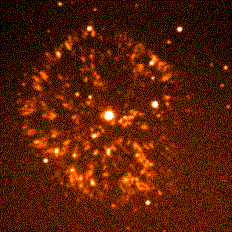Nova Persei 1901 (GK Persei)

Figure 1. Expanding debris from the stellar explosion of GK Persei.

Figure 2. In 1901 Nova Persei became very brilliant and decline very rapidly. The decrease was attended by marked fluctuations.
Nova Persei 1901 (GK Persei) is one of the best-known fast novae. Discovered on 23 February 1901, it quickly reached a maximum of magnitude 0.2, rivaling Capella and Vega, before dropping back to second magnitude 6 days later,and sixth magnitude two weeks after the peak. At this point, a series of oscillations set in, with a periodicity of about four days, and an amplitude of a magnitude and a half. These ups and downs went on for several months, during which time the star continued to fade, until it was no longer visible to the naked eye (Figure 2). The nova returned to its minimum state – magnitude 13 – eleven years after it shot to prominence.
From 1966 to the present, Nova Persei (now more commonly called GK Persei) has shown dwarf-nova-like outbursts of about 3 magnitudes every 3 years. Around 1980, the discovery of X-rays coming from this system led scientists to reclassify the system as a DQ Herculis star or intermediate polar.


